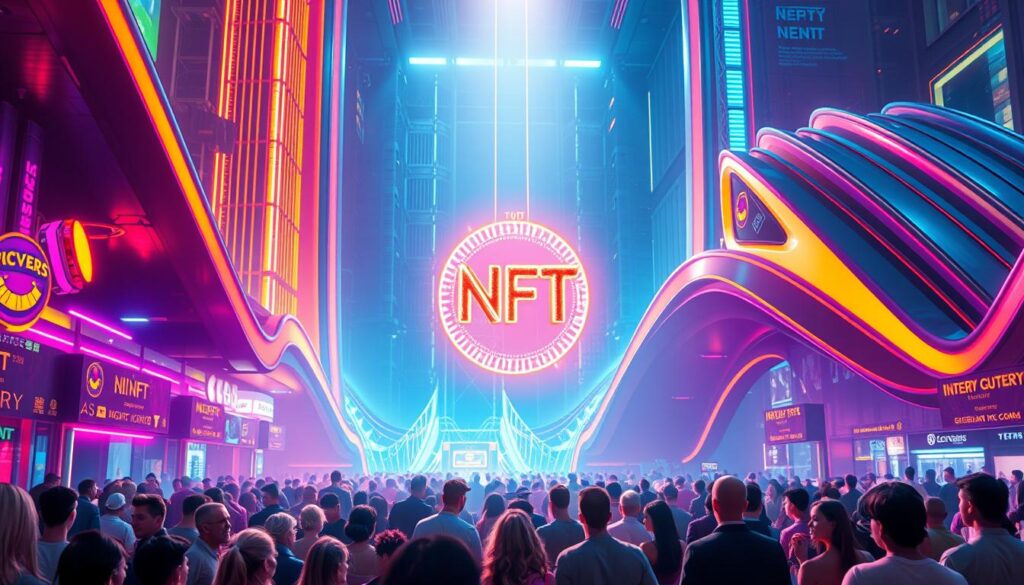This guide maps a practical path to plan, launch, and scale a nft loyalty program that boosts loyalty and long-term value.
The model gives true ownership and tradability, so rewards feel more valuable than typical discounts. Blockchain makes each token tamper-proof and instantly verifiable, increasing trust and perceived worth.
Brands can use token-gating, membership tokens, digital twins, and programmable royalties to deepen ties with customers. The market hit multi-billion-dollar scale, and enterprise-grade design must include security, compliance, and seamless UX from day one.
This introduction previews a step-by-step framework: strategy, design, smart contracts, piloting, rollout, and iteration. It supports hybrid experiences that link digital assets to physical products and measurable KPIs like adoption, retention, and lifetime value.
Key Takeaways
- Ownership and tradability raise perceived value versus point-based loyalty.
- Token utilities—access, memberships, collectibles—strengthen brand bonds.
- Prepare for security, compliance, and cross-device UX early on.
- Expect measurable lifts in adoption, activation, and retention.
- Use a staged rollout: design, smart-contract setup, pilot, then scale.
Why brands are moving to an NFT reward system for customer engagement
Brands are shifting away from punch-card perks toward digital collectibles that people actually own and trade.

Traditional loyalty programs struggle with low personalization and stale points. Many businesses see limited long-term value when members can’t trade or showcase what they earn.
Blockchain technology records each transaction on a decentralized ledger, giving real-time updates and tamper-proof records that cut fraud and boost trust.
- Owned, tradable assets raise perceived benefits compared to simple points.
- Brands such as Starbucks (Odyssey) and Nike use tokenized experiences to drive exclusivity and participation.
- Programs that let people transfer or sell items increase advocacy and richer first-party data.
| Legacy model | Digital collectible model | Outcome |
|---|---|---|
| Points, static tiers | Owned tokens and unique digital art | Higher participation, stronger loyalty |
| Manual reconciliation | Decentralized ledger with real-time updates | Lower fraud, clearer audits |
| Limited exclusives | Gamified drops and early utilities | Fresh experiences across retail, hospitality, and entertainment |
With Web3 tooling maturing, now is a practical time to pilot, validate value, and expand into richer utilities.
Understanding NFTs, blockchain, and Web3 for loyalty programs
Blockchain-recorded assets make each digital item verifiable, scarce, and transferable across platforms.

What one-of-a-kind tokens represent
Non-fungible tokens are unique digital assets that prove ownership and provenance. Each token carries a distinct identifier and a public history. That makes collectibles, membership passes, and digital art traceable and scarce.
How blockchain fundamentals protect value
Distributed validation and consensus keep the ledger immutable. Transactions are cryptographically signed and recorded, which reduces duplication and fraud.
Web3’s role in portability and automation
Web3 enables holders to transfer or trade tokens across platforms. Smart contracts automate issuance and redemption when preset criteria are met. An example workflow: a purchase triggers a contract that mints a token and grants gated access to a special experience.
- Formats: art, media, membership passes, product-linked items.
- Composability: third-party apps can add utilities around the same tokens.
- Security: audit trails, cryptography, and distributed checks lower fraud risk.
| Legacy points | Tokenized items | Impact |
|---|---|---|
| Fungible, pooled points | Unique, tradable tokens | Higher perceived value and resale potential |
| Centralized ledgers | Decentralized blockchain | Improved transparency and auditability |
| Manual redemptions | Smart-contract automation | Faster issuance and reliable access checks |
To explore practical incentives and implementation guidance, see a deeper primer on Web3 incentives and token strategies. This sets up choosing chains, marketplaces, and interoperability next.
Traditional loyalty vs NFT-powered loyalty: what changes and why it matters
Traditional point schemes often reward frequency, not emotional connection.

From fungible points to unique, tradable value
Classic loyalty programs track points that expire or sit unused. These points are easy to issue but hard to make meaningful.
By contrast, tokenized items act as unique collectibles that can grow in perceived value. Scarcity and provenance turn perks into art-like assets and boost brand loyalty.
Exclusivity, gamification, and community
Token-gating creates exclusive tiers and member-only experiences. That elevates status inside a community and drives repeated visits.
Gamification—seasonal drops, leveling, and challenge-based unlocks—keeps people involved. A tier upgrade might grant access to limited releases and private events as an example.
- Static points vs dynamic, tradable tokens that may appreciate.
- Scarcity converts simple perks into collectible art and status markers.
- Holders trade and showcase assets, creating organic community activity.
| Legacy points | Tokenized items | Impact |
|---|---|---|
| Fungible, expiring points | Unique, transferable nfts | Stronger emotional value and secondary-market signals |
| Centralized balance ledgers | Blockchain-backed ownership | Lower fraud and clearer provenance |
| Short-term incentives | Long-term collectible appeal | Deeper brand loyalty and ongoing engagement |
Practical note: Tokenized offerings can augment existing loyalty program setups. A hybrid approach eases transition and preserves proven redemption flows.
Core benefits that boost customer engagement and brand loyalty
Digital collectibles deliver clear business benefits: they create tradable value, unlock gated experiences, and turn single purchases into ongoing relationships. The market reached roughly $22B in 2021, showing real demand and cultural relevance.
![]()
Utility, early access, and token-gated experiences
Practical utilities include discounts bundled with ownership, member-only content, and token-gated communities that reward active members.
Early access mechanics drive timely sales: limited drops or event passes go to holders first, which increases urgency and participation.
Real-time data, interoperability, and cost-effectiveness
Blockchain updates balances and benefits in real time, cutting delays and errors in issuance and redemption.
Interoperability links partners and expands redemption choices across platforms. Algorithmic collections and scalable tooling make minting nfts cost-effective at scale.
Appeal to younger audiences and sustained growth
Millennials trade digital items at higher rates than Gen Z, and owned, tradable assets often feel more valuable than expiring points.
On-chain signals plus opt-in first-party data improve personalization while respecting privacy. Blended offers that tie digital assets to physical products and events create repeat purchases and community-driven growth.
- Perceived value: tradable items beat stale points.
- Operational gains: faster issuance and clearer audits via blockchain.
- Long-term lift: community activity and secondary-market visibility drive sustained brand loyalty.
Step-by-step: how to launch an NFT loyalty program that works
Launch plans should start with measurable business goals and a tight audience definition. Define success metrics, target segments, and the value proposition before any technical work begins.
Define objectives, audience, and value proposition
Start by listing business outcomes: retention lift, repeat purchase rate, or lifetime value. Map these to clear member benefits and tier logic in your loyalty program.
Design NFTs and map reward structures to behaviors
Collaborate on visuals and metadata so tokens reflect brand identity and status. Treat the digital art and traits as meaningful badges that signal progress. Map purchases, referrals, and content creation to specific utilities.
Set up smart contracts, test flows, and pilot the program
Choose standards like ERC-721 or 1155 and define supply, rarity, and upgrade paths. Implement contracts to automate minting, transfers, and redemption so each transaction is reliable.
Conduct end-to-end testing across wallets and devices. Run a contained pilot to validate demand and benchmark KPIs such as adoption and activation. Use that time to refine support flows.
Rollout, communications, and ongoing iteration
Prepare customer education and onboarding docs. Stage utilities and a content calendar to keep momentum after launch. Finally, use on-chain metrics and first-party data to iterate and improve the program over time.
- Design → platform selection → smart contract setup → testing.
- Pilot small, measure, then scale.
- Document onboarding to reduce friction for customers.
| Phase | Primary Goal | Key Metric |
|---|---|---|
| Design | Value mapping | Engagement rate |
| Pilot | Validate demand | Adoption |
| Scale | Optimize ops | Retention |
Choosing your blockchain and marketplace stack
A strategic blockchain and marketplace mix balances scale, costs, and audience fit. Pick options that match your program goals and budget before designing token mechanics.
Chain options
Ethereum gives wide adoption and mature smart contracts. Layer-2s like Polygon cut fees and suit mass minting. Solana offers high throughput for real-time interactions. Tezos emphasizes energy efficiency and creator tools. BNB Chain delivers low fees and fast transactions.
Marketplace fit
OpenSea provides liquidity and multi-chain reach. Rarible adds decentralized governance and storefronts. SuperRare and Foundation focus on curated art drops. Mintable supports gasless minting to lower barriers for mainstream users.
Key considerations
- Compare throughput, fees, tooling, and decentralization against program scale.
- Check wallet compatibility, analytics, and support tooling for mainstream customers.
- Factor developer resources, security history, and community maturity.
- Align product type—collectibles, access passes, or product-linked digital assets—with platform strengths.
| Option | Strength | Best use case |
|---|---|---|
| Ethereum | Robust ecosystem, smart-contract tools | High-value drops and complex logic |
| Polygon | Low fees, L2 compatibility | Mass minting and low-cost participation |
| Solana | High throughput, low latency | Real-time experiences and gaming-like flows |
| Tezos / BNB Chain | Energy-efficient / low-fee options | Creator-focused drops or cost-sensitive programs |
Example: Polygon for low-cost minting plus OpenSea for discovery and distribution gives a practical stack that balances fees and reach while preserving on-chain provenance and value.
Designing reward structures customers actually want
Turn familiar loyalty formats into memorable digital items that carry real privileges.
Start by mapping which behaviors you want to drive—purchases, referrals, content sharing—and match each to a clear benefit.
Points, tiered, paid, and value programs with NFT utility
Points programs translate into collectible tokens that carry utility instead of opaque balances. Members earn unique nfts that unlock specific access or discounts.
Tiered programs use escalating token classes to show status. Higher tiers grant faster perks, exclusive product drops, and VIP event invites.
Paid memberships issue proof-of-membership tokens bundled with bundled perks and priority access. These feel like a subscription that also doubles as tradeable art.
Value-driven programs issue cause-related badges. Customers display these as digital passports tied to charitable actions or brand initiatives.
Balancing digital collectibles with real-world perks
- Link collectibles to tangible benefits: discounts, early product access, or member-only events.
- Personalize tokens so they evolve with behavior and unlock product-specific offers.
- Design scarcity and seasonal drops that align with campaigns and brand moments.
- Keep redemption simple with clear steps and minimal friction.
- Pilot several variants and scale the ones that show measurable lifts in loyalty and sales.
| Structure | What the token does | Best immediate benefit |
|---|---|---|
| Points → collectible tokens | Tracks spend, mints unique item | Discounts and small product drops |
| Tiered tokens | Shows status, unlocks levels | VIP access and exclusive releases |
| Paid membership | Proof of paid access | Priority shipping and bundled perks |
| Value / cause badges | Signals impact, builds community | Public recognition and meaning-driven perks |
Must-have Web3 features to increase loyalty and retention
A concise feature set can make token ownership translate into clear, repeatable benefits. These features create access paths, social proof, and ongoing reasons to return.
Token-gating and exclusive access
Token-gating restricts premium content, VIP communities, and special services to verified holders. Use allowlists and on-chain ownership checks to grant access instantly and at scale.
Plan moderation and community rules to keep gated spaces safe and welcoming.
Membership tokens and evolving profiles
Issue membership tokens that visually evolve with participation. Evolving profile pictures and tier upgrades signal status and encourage further participation.
Make upgrade paths transparent so members know the benefits of each milestone.
Digital twins and programmable royalties
Digital twins preview physical drops and validate authenticity early, boosting anticipation for events and launches.
Programmable royalties can route a share of secondary sales into new utilities or events, funding ongoing program growth.
Purpose-driven drops and early access mechanics
Social-impact releases that donate proceeds to causes align with brand values and attract purpose-driven buyers.
Combine these with early access windows for limited releases, VIP events, or content premieres to reward active holders.
| Feature | Primary Benefit | Operational Note |
|---|---|---|
| Token-gating | Exclusive access | Scalable verifiable checks |
| Evolving membership | Repeat participation | Clear upgrade rules |
| Digital twins | Authenticity & hype | Sync with physical supply |
| Programmable royalties | Ongoing funding | Transparent split rules |
Transparency about utilities, timelines, and roadmaps keeps trust high. Track on-chain signals like quests to unlock evolving perks and maintain momentum.
Integration and UX: making NFTs effortless for customers
Smooth onboarding and seamless checkout turn complex token flows into simple shopping moments.
Start with easy wallet options. Offer custodial choices, social logins, and email-based wallets so new users skip cryptic setup steps.
Wallet onboarding, gasless minting, and flexible payments
Minimize friction by supporting gasless minting on Layer-2s or marketplaces that sponsor fees. This makes minting feel instant and affordable.
Let people pay by card or crypto. Multiple payment paths bring both web-native and Web3-native buyers into the same flow.
Intuitive interfaces, clear instructions, and support
Design plain-language flows with tooltips and progress bars. Short, step-by-step help reduces drop-offs.
Provide FAQs, live chat, and tutorials to resolve issues fast and keep trust high.
- Custodial or social wallet options reduce setup time.
- Gasless minting and low-fee chains cut friction at claim.
- Flexible payments widen reach and conversion.
- Responsive UI with clear status and ownership checks improves trust.
| Challenge | UX solution | Expected impact |
|---|---|---|
| Complex wallet flows | Social login / email wallet | Faster onboarding, higher adoption |
| High gas fees | Gasless minting on L2s | Lower cost, instant claims |
| Mixed payments | Credit card + crypto checkout | Broader reach, fewer abandoned carts |
Integrate with e-commerce so ownership auto-applies discounts, shipping perks, or gated access at checkout. Track UX metrics like drop-off points and time-to-redeem to iterate on flows.
Security, compliance, and data strategy for enterprise-grade programs
Enterprise loyalty initiatives must treat security and privacy as core product features, not afterthoughts. Start with audited contracts and clear custody rules to protect assets and trust.
Smart contract audits, authentication, and fraud prevention
Prioritize third-party audits and formal verification to catch logic flaws before launch.
Implement strong authentication and ownership checks to reduce phishing and account takeovers. Monitor transactions in real time and set automated alerts for anomalies.
Privacy, data capture, and real-time analytics
Align data practices with regulations and tell users what you collect and why. Combine on-chain events with consented first-party data to personalize offers ethically.
Build dashboards that track adoption, activation, retention, and redemption so business teams can iterate quickly.
- Key management policies and secure custody for program wallets.
- Vendor vetting, certifications, and periodic pen tests.
- Incident playbooks and coordination with legal on tax, IP, and consumer rules.
| Area | Best practice | Business impact |
|---|---|---|
| Smart contracts | Third-party audit & formal verification | Lower exploit risk, higher trust |
| Authentication | Multi-factor and ownership checks | Reduced account takeovers |
| Data & privacy | Consent-first capture, regulatory alignment | Safer personalization, legal compliance |
| Monitoring | Real-time analytics and anomaly detection | Faster response, improved retention |
Measuring impact: engagement, retention, and lifetime value
Quantifying impact starts with a small set of reliable signals tied to revenue and retention. Define clear north‑star metrics and report them often. That focus helps teams move from experiments to repeatable gains.
KPIs to watch
Adoption: new member signups and mint rates. Activation: time from signup to first meaningful action. Secondary‑market signals such as resale volume and floor price act as proxies for perceived value.
- New member adoption, activation speed, and active holder rates.
- Redemption, repeat participation, and churn to monitor program health.
- Segment cohorts by behavior to tailor utilities and messaging.
Iterate with tests and community input
Run A/B tests on access tiers, drop timing, and utilities. Use surveys, AMAs, and an open roadmap to gather feedback. Attribute changes to revenue and lifetime value so business teams see impact.
| Metric | Example | Action |
|---|---|---|
| Adoption | Signups per drop | Adjust marketing and UX |
| Secondary signals | Resale volume | Revise scarcity or perks |
| Support & UX | Time-to-resolution | Cut friction in flows |
Report results transparently and iterate on cadence. For deeper research on metrics and methodology, see this research primer.
Where NFT loyalty is heading next: building durable customer relationships
Loyalty is shifting toward interoperable digital assets that move across partner ecosystems and unlock perks in both commerce and live events. Adoption is accelerating as brands like Starbucks layer experiential access onto traditional points and collectible items.
Decentralized communities drive co-creation, while programmable royalties fund ongoing benefits and new utilities. Expect broader mainstream access via gasless flows, custodial wallets, and clearer regulation that lower barriers to participation.
Practical advice: pilot a hybrid loyalty program, measure retention and LTV, and iterate with your community. Start small, scale what proves durable, and keep ownership, privacy, and clear value at the center of every launch.
FAQ
Q: What does implementing an NFT loyalty program involve for a brand?
A: Implementing a loyalty program that uses unique digital tokens requires clear objectives, a defined audience, and a strong value proposition. Brands first design the digital assets and map rewards to customer behaviors. They then set up smart contracts, pilot the experience, and launch with ongoing communications and iteration. Key parts include wallet onboarding, gasless minting options, and an easy user interface to reduce friction.
Q: Why are brands moving to NFT-based loyalty and what benefits do they see?
A: Companies adopt tokenized loyalty to offer exclusivity, gamification, and community engagement. These programs create tradable value, early access to products or events, and token-gated experiences that deepen brand attachment. They also deliver real-time data, interoperability across platforms, and cost-efficiencies compared with traditional point systems—especially when targeting younger, digitally native audiences.
Q: How do digital assets, blockchain, and Web3 support modern loyalty programs?
A: Digital assets give proof of ownership and provenance, while blockchain ensures immutability and transparent transactions. Web3 enables transferability and interoperable rewards so collectibles can function across marketplaces and partner ecosystems. Together they support membership tokens, programmable royalties, and secure verification that enhance long-term customer relationships.
Q: How does a tokenized loyalty program differ from traditional points-based systems?
A: Traditional programs use fungible points tied to a single brand ledger. Tokenized programs issue unique items that can carry utility—access, perks, or resale value—outside the brand’s own system. This shift boosts perceived scarcity, encourages secondary-market activity, and enables richer community-driven experiences and data signals.
Q: What core benefits should brands aim to deliver to boost loyalty and retention?
A: Focus on utility like early access, exclusive events, and token-gated content. Add gamified tiers, real-time analytics, and interoperability so tokens work across platforms. These elements increase lifetime value, attract younger consumers, and sustain brand growth through ongoing engagement and tailored perks.
Q: What are the practical steps to launch a loyalty program that works?
A: Start by defining goals and target segments, then design tokens and map reward triggers. Build or choose smart contracts and test flows with a pilot group. Prepare communications, partner with marketplaces if needed, and use A/B testing and community feedback to iterate. Ensure customer support and simple onboarding throughout.
Q: Which blockchains and marketplaces are commonly used for loyalty projects?
A: Popular blockchains include Ethereum, Polygon, Solana, Tezos, and BNB Chain, each offering different trade-offs in fees and scalability. Marketplaces such as OpenSea, Rarible, SuperRare, Foundation, and Mintable help with distribution and secondary sales. Choose a stack based on ecosystem compatibility, transaction costs, and long-term goals.
Q: How should brands design reward structures customers actually want?
A: Combine points or tiered models with collectible utility and real-world perks. Offer redeemable experiences, limited-edition art, and evolving membership tokens. Balance digital scarcity with practical benefits like discounts or event access to ensure wide appeal and lasting engagement.
Q: What Web3 features are must-haves to increase retention?
A: Implement token-gating for exclusive access, membership tokens for recurring benefits, and programmable royalties to reward creators and the community. Consider digital twins, social impact initiatives, and evolving profile pictures to strengthen emotional connection and brand alignment.
Q: How do you make blockchain experiences effortless for customers?
A: Offer simple wallet onboarding, gasless minting, and multiple payment options. Use intuitive interfaces, clear step-by-step instructions, and live support. Reducing technical friction is essential to adoption and positive user experience.
Q: What security and compliance measures should enterprises take?
A: Conduct smart contract audits, implement strong authentication, and use fraud-prevention tools. Establish privacy controls for data capture, follow regulations around digital assets, and maintain real-time analytics to detect anomalies while protecting customer information.
Q: How should brands measure the impact of their loyalty initiatives?
A: Track KPIs like adoption, activation, retention, secondary-market activity, and changes in lifetime value. Use community feedback and A/B testing to iterate offers. Monitor transaction data and engagement signals to refine value propositions over time.
Q: What future trends will shape tokenized loyalty and brand relationships?
A: Expect tighter integration with retail, live events, and digital art marketplaces, plus growth in interoperable experiences across platforms. Membership economies, programmable royalties, and meaningful social impact programs will help brands build durable relationships and deeper customer loyalty.


No comments yet